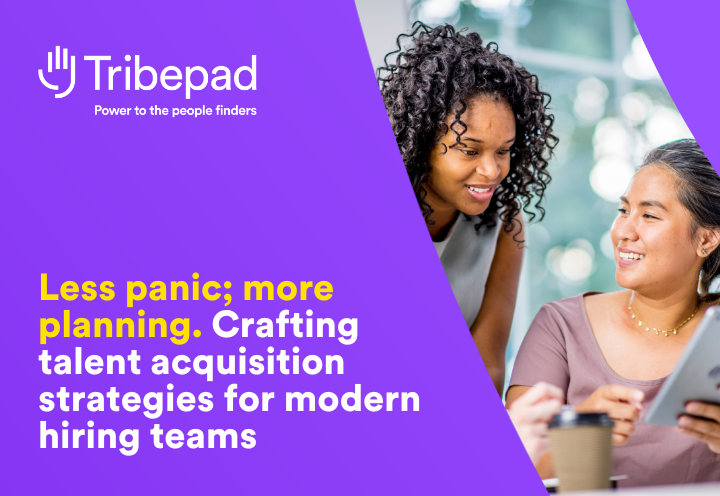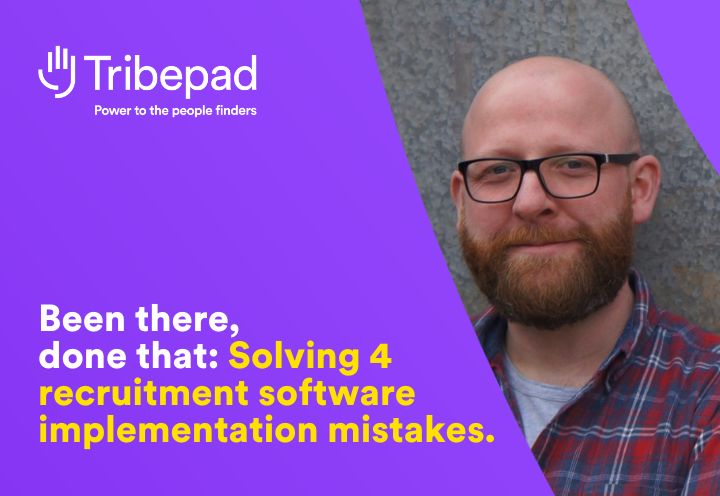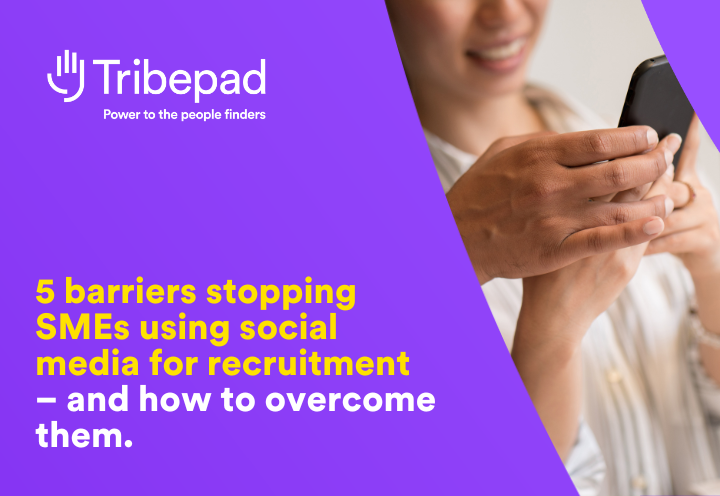The internet is awash with listicles of so-called “recruiting best practices” that’ve been around for the last decade. But what real-world tactics are talent leaders actually prioritising, for effective recruiting in a landscape turned on its head by GenAI? Here are eight high-impact recruitment strategies to focus on right now.
Recruitment has never stood still, but recently the talent acquisition landscape has felt like a toddler with the zoomies. Hiring teams are battered by a storm of change:
- The tidal wave of generative AI redefining how hiring happens
- Escalating pressure for TA leaders to prove their value
- Rising candidate expectations for fast, fair, modern processes
- Growing backlash against DEI – while DEI remains business-critical
- A new generation of workers demanding total authenticity
And as much as you’d like to batten down the hatches, make a cuppa, and wait it out, this weather’s not going anywhere.
GenAI isn’t getting back in the box; jobseekers won’t re-settle for dinosaur treatment; C-suite leaders won’t forget the expectations for TA teams to deliver concrete, measurable business value.
Recruiters have no option but to stick the waterproofs on, steel your stomach, and step out into the onslaught.
The recruitment best practices that worked five years ago won’t cut it today. To thrive, HR and TA leaders need to evolve – building processes that are fairer, faster, and better for everyone.
Here are eight recruiting strategies we see hiring teams focussing on right now.
8 recruiting best practices for a world turned on its head
1. Embrace skills-based hiring
CVs are easily manipulated, unfair, and rarely predict real performance – and that was before AI. In a post-AI world, CVs are less useful than ever.
Whether you abandon CVs altogether or integrate skills-based assessments and video screening alongside, recruitment best practice means focussing on behaviours, learning agility, and potential rather than past performance.
Skills-based hiring in action: Siemens
CEO of Arctic Shores, Estelle McCartney, joined us recently for episode 11 of The View, to talk about skills-based hiring. She shared an example from Siemens, who’d decided to pilot CV-free recruitment against one role that had been open for hundreds of days.
The approach resulted in a shortlist of eight candidates who’d never have otherwise made it through a CV sift. And a surprised call from the managing director saying the list was so high-quality he could hire all of them. Now Siemens are looking to roll-out skills-based hiring across other business units – so the proof’s in the pudding, really.
2. Prioritise brand consistency
In 2025, employer brand is under the microscope. Brand has always mattered but today there’s truly nowhere to hide. With AI tools able to instantly surface every review, news story, and social post about your organisation, a weak or inconsistent employer brand is ruthlessly exposed.
With tighter budgets and tougher competition for scarce skills, a strong, consistent (and authentic!!) brand is one of the most powerful recruiting strategies and hiring best practices for 2025.
But credibility hinges on consistency – from LinkedIn to interview; from job ads to onboarding. If you say you’re innovative but your recruitment feels hopelessly outdated, credibility collapses. Likewise, if you promise “people first” while leaving candidates in the dark.
Employer brand isn’t a marketing exercise. It’s the sum of every candidate and employee experience. When your brand shows up consistently and hiring reflects your values at every stage of the recruitment process, you amplify trust, drive applications, improve offer acceptance and strengthen retention.
According to Staffing Industry Analysts, 47% of candidates say they see inadequate employee-featured content from employers, leaving an authenticity gap that erodes trust.
As AI makes researching easier but differentiating harder, branding is a recruitment strategy leaders can’t afford to ignore.
3. Hire in days and weeks, not months
In a market where critical skills are scarce, slow processes mean losing top talent to faster-moving competitors. TA teams must prioritise tight processes, lots of automation, and easy, intuitive recruitment tools that make it easier to hire fast. Like, fast fast.
Staffordshire County Council doubled their fill-rate while cutting time-to-hire by a third using Tribepad’s ATS.
That’s not even recruiting best practice anymore – it’s table stakes, as hiring teams leverage AI to skyrocket efficiency.
If you’re processing candidates 10x slower than other organisations they’ve applied to, the fact is that you’ll lose a lot of people. In 2025, recruiting should take days and weeks, not months. Or you’ll struggle to recruit at all.
Tribepad Sidekick saves hiring teams 3 hours 20 minutes per hire based on your average number of applicants. What does that look like scaled across your hiring function?
4. Prove quality of hire
AI makes speed gains possible that you could only have dreamed about yesterday. But CFOs and CEOs increasingly want proof that recruitment delivers lasting business value. Hiring quickly is important, but hiring well is what drives retention, performance and culture.
Recruitment leaders who only report speed metrics risk being seen as cost centres. Tracking and improving quality of hire (however you define it) is one of the most powerful markers of effective recruiting today.
That’s what’s going to matter when your CFO crunches the numbers on your team overheads. And when you make your case for TA’s seat at the table.
We spoke to BT Group’s Head of Volume Recruitment, Matt Howe, about the best recruiting practices for high-volume hiring. He talks about the importance of great data to help understand quality of hire, so you can continually optimise the hiring journey to bring in the right numbers of the right people.
5. Fight for DEI
DEI programmes are under pressure in 2025, with budgets being cut and political scrutiny rising. But the business case is stronger than ever.
Best practice is no longer about high-level pledges. One of the most critical recruitment best practices today is embedding fairness into the end-to-end machinery of recruitment.
In our Stop the Bias 2025 report, candidates told us they fear bias across a wide spectrum of factors – from age to accent; appearance to parenthood. Too often, employers focus on a narrow slice of issues while overlooking the biases candidates feel most keenly. Closing that gap is a brand differentiator as much as a fairness imperative. It’s integral to effective hiring.
That means:
- Inclusive job descriptions that welcome all backgrounds
- Transparent, respectful communication (no ghosting)
- Fair shortlists and structured assessments that show bias isn’t tolerated
When you show candidates their concerns are heard and acted on, you don’t just reduce bias — you build trust and reinforce your EVP.
A trailblazer in diversity, Channel4 offers a great example here. We spoke to CMO, Zaid Al-Qassab, about five practical ways Channel4 builds an inclusive, diverse and creative culture.
6. Integrate AI – thoughtfully
AI has huge potential to transform hiring, yes. But there are wider concerns about ethics, transparency, and ROI to consider too. “Use more AI” isn’t a recruitment strategy.
Willo’s Hiring Trends 2025 report finds that 53% of recruiters who’ve adopted AI are already planning to change the tool they use, for example. That stat tells a story of talent acquisition functions rushing headlong into AI, with plug-in and bolt-on tools that ultimately drain resources without delivering value.
The truth is, if your processes suck, sticking AI on top doesn’t solve anything. AI recruitment tools can be great but they’re not a magic bullet that turns slow, jangly hiring functions into an efficiency and effectiveness powerhouse.
Modern recruitment strategies are about integrating AI in a thoughtful, measured way into processes that work. Take your time to map out your processes and then explore how AI can weave in to genuinely add value.
That’s the approach we took with Tribepad Sidekick. It’s a thoughtful, ethically-aware, fully-integrated AI hiring partner that’s built for long-term progress, not just short-term profit. (Although that too, with projected savings of £10,093 per 100 hires…)
7. Nail recruitment data
In 2025, your C-suite expects hard proof that recruitment is a value driver, not a cost centre. Talent acquisition leaders are under pressure to show that every hire contributes to business outcomes. Vanity metrics won’t cut it.
GenAI has made this shift even sharper. Speed and volume can now be artificially inflated but leadership teams know fast isn’t the same as good. They want data that links hiring to retention, performance, diversity, and culture. If TA leaders can’t provide that story, they risk being sidelined when the next round of cuts comes.
Recruitment data isn’t just a reporting tool. It’s your most powerful weapon to prove value, unlock resources, and improve hiring decisions. Good recruitment reporting is how you shift recruitment from a ‘cost centre’ to a driver of business success.
To deliver recruiting best practices, you’ll need the right tools. The right recruitment software should capture, connect, and clarify your data, so you can tell stories with punch. That’s what Tribepad delivers. Read the story
Tribepad’s recruitment reporting is a massive win. It’s phenomenal to have a system that can give business insights at this level; it’s given us visibility and accountability. There’s nothing it can’t tell you; it’s such a powerful tool.
8. Strengthen recruiter–hiring manager collaboration
Recruiter–manager alignment has always mattered, but with GenAI it’s become business-critical. Now candidates can apply for 100s of roles in minutes, often with AI-polished CVs and cover letters. In other words: volume up, differentiation down.
If recruiters and managers haven’t agreed what really matters – specific skills, behaviours, success markers – it’s almost impossible to sift. Without crystal-clear alignment, recruiters drown in “maybes” instead of focusing on true fits.
Plus at the same time, automation is speeding up early-stage processing. AI-powered screening is great (it’s one of the best parts of Tribepad Sidekick 👀) but if the recruiter–manager brief is fuzzy, automation just makes poor alignment happen faster.
In a GenAI-powered world of both volume and velocity, recruiter-manager collaboration is the difference between a streamlined process and a spiralling mess.
Better collaboration is the heart of Tribepad’s talent acquisition platform:
- Mobile-friendly manager self-service dashboard
- Candidate summaries for speedy manager attention
- @tagging to pull collaborators in-platform (and off email)
- Shared scorecards to create consistent evaluation criteria
- Review, score, and shortlist from one shared dashboard
- Notifications dashboard so nobody misses what matters
- Endlessly flexible workflows that match how you work
There’s no such thing as bad weather – only bad gear ⛈
Recruitment will keep shifting under our feet. We know that GenAI isn’t going away, candidate expectations won’t soften, and boards won’t stop demanding proof of value.
But best recruiting practices like these are your waterproofs. With the right hiring strategies, you won’t just weather the storm. You’ll build a hiring function that thrives in it. That’s what recruiting leadership looks like in 2025.
Tribepad is the trusted tech ally to smart(er) recruiters everywhere. Combining ATS, CRM, Video Interviewing, and Onboarding, our talent acquisition software is a springboard for fairer, faster, better recruitment for everyone.
Trusted by organisations like the Tesco, NHS Professionals, and Subway, 30-million people in 16 languages use Tribepad.



